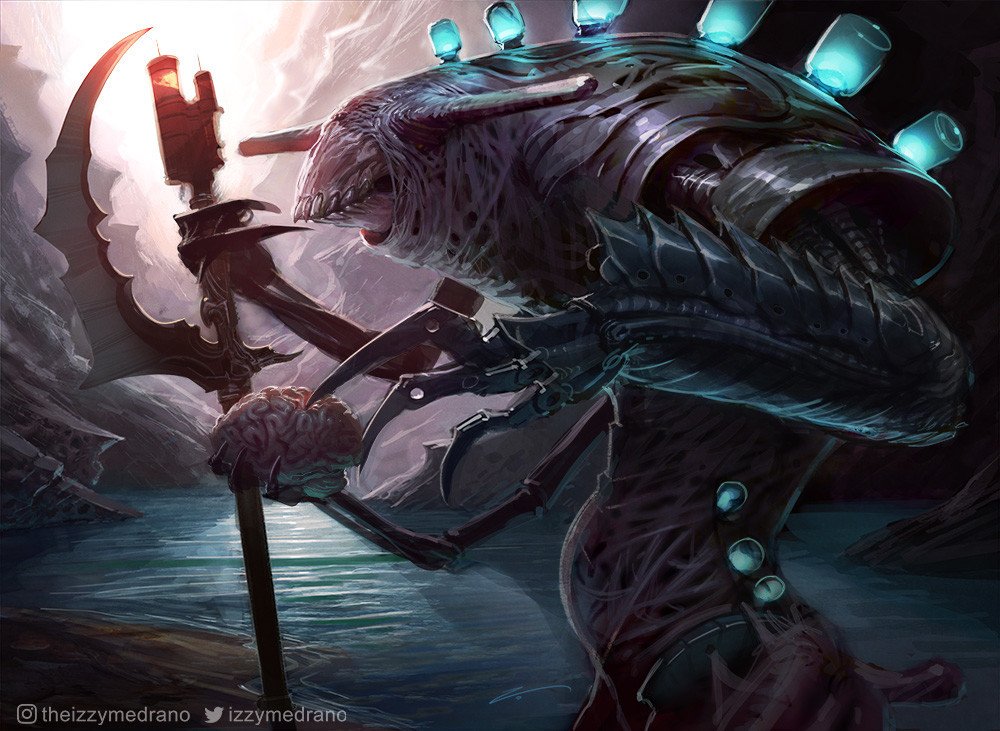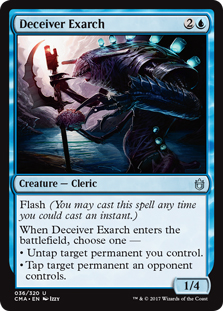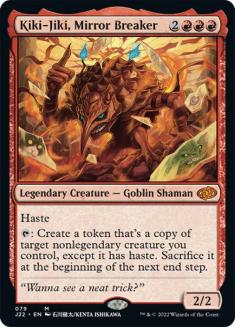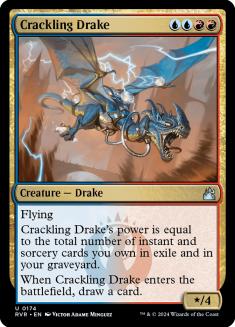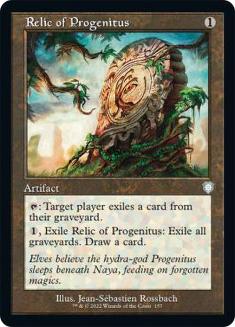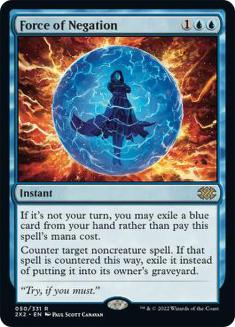No, you didn’t miss some surprise announcement. Splinter Twin is not unbanned. Even if it were, it’s not a foregone conclusion that an Izzet Twin deck would immediately leap to the top of the format, though it would clearly return to the world of playability and would make for a mighty exciting shake-up to contemporary Modern. I’d love to see it, personally, but it turns out that the unban isn’t even necessary!
As we can see from the results of a few recent events, a growing contingent of players on Magic Online (MTGO) have been finding success with a strange Izzet deck that incorporates Deceiver Exarch alongside its number-two co-conspirator.
Kiki-Jiki, Mirror Breaker still does what Splinter Twin no longer can, and it’s possible that opponents have forgotten how to properly sequence against a deck like this one. Even a dramatically weaker version of the old Splinter Twin archetype, blended into a control shell with some powerful new tools from 2020, manages to pull together more wins than you’d expect. Don’t call it a comeback, but I’d be overjoyed to get to play a control-combo deck again and I’m sure there are many others like me out there.
MTGO player Tiemuuu has been the driving force behind this innovative thrust in the staid world of Modern, and has taken an approach that may make people scratch their heads. Regardless, it’s working, and others have followed suit after a few successful tournament runs with the deck.
My personal favorite username shows extreme devotion to their preferred archetype, and you’ve got to hand it to a player who chooses to call themselves “twinlesstwin.” Here’s their version of the deck, in all its amusing, yet surprisingly powerful glory:
Creatures (13)
Lands (17)
Spells (30)

It would be too easy to dismiss this deck out of hand.
Kiki-Jiki instead of Splinter Twin makes the combo vulnerable to Lightning Bolt.
This deck is full of clunky, expensive cards that aren’t powerful enough to compete with Uro, Titan of Nature’s Wrath. You can’t even destroy one if it gets escaped!
The mana curve is too high, and Crackling Drake is not strong enough for Modern as a maindeck threat.
You’re playing Boil in your deck with three Islands. Are you out of your mind!?
As it turns out, things aren’t quite as cut-and-dried as you might think at first glance.
The most important element of dissonance to address, of course, is the Boil in the room. The first time I remember seeing Boil in a blue deck, it was a Jacob Wilson and Alex Hayne meme video with Boil in Merfolk, using Spreading Seas, Sea’s Claim, and Tideshaper Mystic to turn opposing lands into Islands for islandwalking goodness alongside the opportunity to Boil away their hopes and dreams. How did they avoid having their own lands struck? They played Oboro, Palace in the Clouds; Minamo, School at Water’s Edge; Shivan Reef; and other blue-producing lands that weren’t Islands. They didn’t even have access to Spirebluff Canal or Riverglide Pathway like we do today!
This was, of course, a total joke. But 2020 has a way of turning things that one might have previously thought too ridiculous to seriously contemplate…into things that we must seriously contemplate.
Today, we see Boil as a potential instant-speed win against many of the common Uro midrange decks. It’s also excellent when the opponent plays with Dryad of the Ilysian Grove, as it has turned the Prismatic Omen effect into a liability. With only three Islands in the deck, the presence of Boil isn’t excessively self-destructive, though it is non-intuitive. I have to admit, I never thought I would see a deck playing so many triple-blue spells alongside Boil, but it’s actually the best sideboard card in the format against the more controlling versions of the Uro decks. (I do suspect that Uro will eventually be banned in Modern in 2021, but we haven’t reached that point yet.)
Of course, we can only do this because we’re blessed with an incredible and diverse selection of two-color lands, including some of the most amusing runners-up in contemporary Magic history. Cards like Reflecting Pool and Cascade Bluffs have been around a time or two, but it’s been many years since they were last front and center in a competitive manabase like they are here. Cascade Bluffs, in particular, is a necessity in a deck trying to cast both Archmage’s Charm and Kiki-Jiki. It’s the perfect land to stitch together this patchwork of awkward bedfellows.
Speaking of awkward bedfellows, no one would disagree that Crackling Drake appears a little odd here. It’s a four-mana sorcery-speed threat in a deck that ostensibly works at instant speed, and it attacks and blocks in a deck that is deliberately adding lower-power cards in order to have a combo finish. It seems at first glance like you would want to either have more combo pieces or get rid of the combo altogether and just be Crackling Drake control with Thought Scours. What gives?
The combo, to be frank, is almost never going to execute on Turn 5. It’s not usually going to happen on Turn 7. It’s more of a Turn 12 combo, after going through nearly half the deck and establishing multiple counterspells’ worth of backup. Sure, if the opponent taps out, you can steal a win here or there with these threats, but the purpose of the deck is to extend the game until an opportunity arises to jam the combo with varying amounts of protection.
So why Crackling Drake? It’s simply the best single-card threat that demands an answer and that you can cast in the mid-game and force an opponent to respond to. At that time, you get to untap and try to run out your whole combo in a single turn. (Keep in mind, with the Kiki-Jiki version of the combo, you can win the game given seven untapped lands even without a Deceiver Exarch on the battlefield from a previous turn.)
It’s not the best threat in Modern for its mana cost, but it’s the best threat for the job. Obviously it’s a weaker card in a vacuum when compared to a powerhouse like Jace, the Mind Sculptor, and I’m not convinced that zero Jaces is correct, but Crackling Drake has a lot going for it as a removal magnet and a one-shot way to win the game.
Of course, there is the elephant in the room that needs to be addressed: the disturbing inability for this deck to answer an escaped Uro. Short of a double Lightning Bolt or a Cryptic Command to inefficiently bounce it, there’s not much to be done about this annoying threat. Similarly, a resolved Wrenn and Six is big trouble as a source of land drops forever. What’s the solution? We’re looking at it, but for some reason, folks won’t go through and be serious about addressing this weakness!
The presence of two Relic of Progenitus is better than the nonsense I’ve seen in some sideboards – Soul-Guide Lantern? Come on! – but we need at least a third, and possibly a fourth. It’s important to consistently ensure that the annoying graveyard recursion engine doesn’t come online. Incidentally, Relic of Progenitus is an excellent card against the annoying Oops All Spells deck that has cropped up on MTGO as a quick way to burn through Leagues and try to grind up a few tickets. The extra copies here will pay dividends in two of the most common and important matchups in Modern.
The assorted newer trinkets to add to this deck are all important in their own ways, such as Modern Horizons newcomers Flusterstorm, Archmage’s Charm, and Magmatic Sinkhole; Valakut Awakening as an instant-speed pseudo-Tolarian Winds; and (what else?) the sideboard copies of the great Cleansing Wildfire.
While previous incarnations of Izzet Twin relied on Blood Moon against big mana decks like Mono-Green Tron to try to slow them down long enough to execute a combo finish, we don’t get to play that particular card. It’s a blessing in disguise, actually. Blood Moon was always fine against Urzaron strategies, but was significantly less game-ending than it appeared on first glance. Cleansing Wildfire as a cheap cantrip that digs you towards your combo while knocking the opponent off Urzaron, though, is a great addition. Certainly, you’re not as happy playing against Mono-Green Tron when your combo is a mana more expensive, but with the ability to keep the opponent off a serious threat for multiple turns, it’s not all that bad.
Call me crazy, but I want a sideboard to start with four copies of Relic of Progenitus and four copies of Cleansing Wildfire. Follow it up with two Boil, two Engineered Explosives (which is stellar against Rakdos Death’s Shadow and Death and Taxes), and a couple of counterspells, and you’ve got a real sideboard to be proud of.
Speaking of counterspells, one thing that doesn’t make sense here is the lack of Force of Negation. Force of Negation seems critical as an answer to cards all the way from Wrenn and Six to Amulet of Vigor, and yet it’s not here. The deck has a high density of blue cards, and is likely to want to protect itself while short on mana, so why not include a copy or two? With so many copies of Opt and Serum Visions, there shouldn’t be a huge cost to exiling an extra blue card from your hand.
I’d be interested in adding to the mix of Remand, Spell Snare, Cryptic Command, and Archmage’s Charm by including another high-power card from recent years. It’s hard to go wrong with these new cards; they’re often simply better tools for the job than older ones. And that heuristic proves true for more than just Force of Negation as a reactive spell. It’s present all over the format.
Let’s be clear. In terms of raw power, there’s nothing in Modern that’s going to approach the individual power level of the Uro and Omnath decks. Whether you’re playing the stock list or some variant with a bit more spice, your individual card quality is through the roof with that archetype. And how could it be otherwise? All of the threats are busted cards printed in the last two years!
In order to beat a deck with that kind of extraordinary power level, it takes some unique maneuvering. You’re going to have to do weird stuff. Sometimes that means playing Boil in your blue deck. Sometimes that means picking up a long-dead archetype and repairing it.
But let’s be honest, how amazing is that feeling when you surprise your opponent with a Boil during their end step? And pulling out a trick from 2015 by winning with a million Deceiver Exarchs? Priceless. Break out this deck and throw it back to a simpler time, and leave your opponent scratching their head, wondering if your deck is even real, or just another bizarre joke to cap off a surreal 2020!

